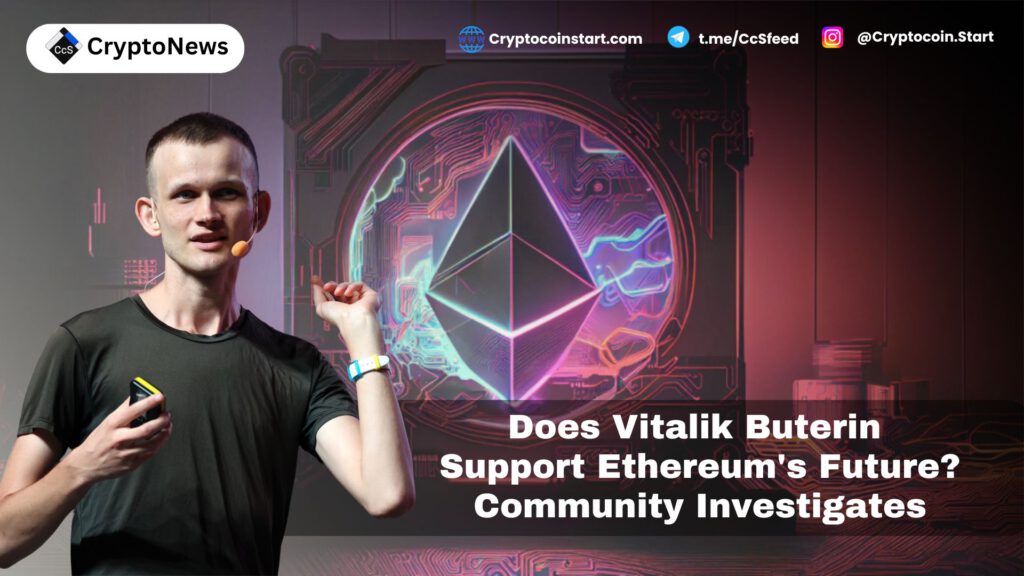
Is Vitalik Buterin Skeptical of Unichain? Community Digs Into Past Comments
As Unichain launches, speculation has emerged around Vitalik Buterin’s stance on the project. The Ethereum co-founder’s previous comments have led some to believe he is not in favor of Unichain, sparking considerable debate within the crypto community. Buterin’s critique, initially shared on X (formerly Twitter), has resurfaced, adding fuel to the ongoing conversation about Unichain’s potential and Uniswap’s latest Layer-2 ambitions.
Buterin’s Past Critique of Unichain Resurfaces
Vitalik Buterin’s comments on Unichain date back to September 2022, when he expressed doubts about the idea of Uniswap launching its own Layer-2 solution. At the time, Buterin argued that Uniswap’s main value was in facilitating easy and accessible trading. He suggested that a Layer-2 (L2) rollup for Uniswap might complicate its simplicity and questioned the platform’s need for a dedicated L2 solution.
According to Buterin, Uniswap could be more successful by deploying across existing rollups instead of creating a new one. This opinion has ignited discussion, with some in the community seeing Buterin’s comments as “meddling” in Uniswap’s vision.
Unichain Launches Despite Buterin’s Initial Reservations
Despite Buterin’s previous comments, Uniswap proceeded with its own Layer-2 solution, and two days ago, Unichain’s testnet officially went live. Designed as a cross-chain interoperability solution, Unichain functions as a decentralized validator network. The platform aims to offer enhanced transaction speed and efficiency, targeting near-instant settlement times.
Unichain’s core features include:
- Cross-Chain Interoperability: Enables seamless interaction between different blockchain networks.
- Decentralized Validator Network: Establishes a decentralized system to validate transactions, improving network security.
- Fast Transaction Settlements: Unichain aims for a one-second block time with an ultimate goal of reaching sub-250 millisecond block times.
Unichain is designed to be open-source, which allows other projects to adopt its blockchain infrastructure and enhance compatibility across different DeFi platforms.
Uniswap’s Vision for Unichain: Solving DeFi Challenges
Uniswap’s motivation for developing Unichain lies in addressing two main DeFi pain points: high transaction costs and network speed. Unichain is structured to alleviate these issues by offering quicker transaction processing, significantly reducing gas fees, and enhancing market efficiency.
Through partnerships with Flashbots and Optimism, Uniswap’s technical framework aims to counteract issues associated with Maximal Extractable Value (MEV), where miners or validators can extract additional value from transactions. By reducing MEV, Unichain seeks to improve user experience and foster a more efficient trading environment.
Market Reaction: UNI Token Sees Price Surge Amidst Unichain Launch
The launch of Unichain’s testnet has had a positive impact on Uniswap’s native token, UNI. Following the announcement, UNI saw a notable uptick in market value, trading at $8.19 with a 3.94% gain over the last 24 hours and over 20% growth in the past week. This surge underscores the market’s optimism surrounding Uniswap’s Layer-2 expansion.
Key UNI metrics as of now include:
- Current Price: $8.19, reflecting a 3.94% increase over 24 hours.
- 7-Day Growth: Over 20% in market value.
- Trading Volume: $316.89 million, though volume has decreased by 26.68% in the last 24 hours.
The decrease in trading volume could indicate a period of consolidation as traders reassess the short-term potential of UNI and other related assets. This volume dip might represent a natural retest after recent volatility, rather than a lack of investor interest.
Growing Ethereum Layer-2 Ecosystem and Unichain’s Place Within It
The proliferation of Ethereum Layer-2 solutions highlights the ongoing efforts to address Ethereum’s scalability issues. Data from L2Beat suggests that the crypto sector currently has 105 Layer-2 protocols aimed at enhancing Ethereum’s functionality and efficiency. Among these solutions, Arbitrum, Base, and Optimism’s OP Mainnet are leaders in Total Value Locked (TVL):
- Arbitrum: $13 billion TVL, the highest among Ethereum Layer-2s.
- Base: $7.2 billion TVL, operated by Coinbase.
- OP Mainnet: $5.8 billion TVL, developed by Optimism.
Ethereum Layer-2 protocols focus on scaling Ethereum’s capacity, reducing transaction costs, and enhancing user experience. Unichain adds a unique layer of interoperability, which could position it as a valuable player in the L2 ecosystem as it matures and gains traction.
Vitalik Buterin’s Ongoing Role in Ethereum’s Development
Despite his reservations about Unichain, Vitalik Buterin remains committed to Ethereum’s growth and scalability. Recently, Buterin outlined his vision for Ethereum’s future, emphasizing a need for “legible alignment.” Buterin’s goal is to enhance Ethereum’s usability and accessibility, reinforcing the platform’s foundation and preparing it for future growth.
Buterin’s approach often includes actively engaging with Layer-2 developments, indicating that his critical stance on Unichain may reflect his dedication to Ethereum’s long-term alignment and efficiency. However, as Layer-2 solutions become increasingly popular, his influence may be tempered by the ambitions of other projects, such as Uniswap’s Unichain.
Conclusion
The community’s focus on Buterin’s past comments about Unichain underscores the impact of his influence on the DeFi sector. Uniswap’s launch of Unichain is a testament to its commitment to addressing key challenges in DeFi, particularly those surrounding speed and transaction costs. While Buterin may have reservations about the project, Unichain has already demonstrated its potential to reshape Uniswap’s reach within the Ethereum ecosystem.
With Unichain’s testnet now live, Uniswap can potentially broaden its market presence and secure its position in the growing Layer-2 landscape. As Unichain moves toward a mainnet launch, the outcome of Uniswap’s bold step into Layer-2 could set a new standard for decentralized exchanges and cross-chain compatibility within the DeFi sector.

